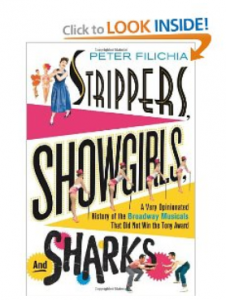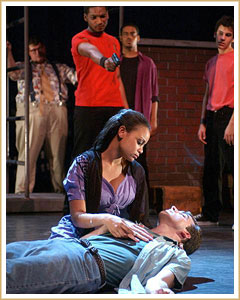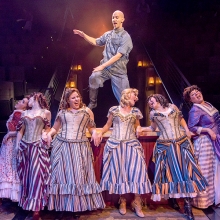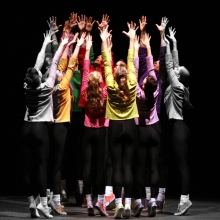Filichia Features: That Ol’ Reliable West Side Story
Filichia Features: That Ol’ Reliable West Side Story
 Last week, while reviewing Les Miserables School Edition, I suggested that producing the British mega-hit may lead to one unexpected benefit.
Last week, while reviewing Les Miserables School Edition, I suggested that producing the British mega-hit may lead to one unexpected benefit.
It may be a logical successor to West Side Story in attracting boys into musical theater.
I quoted Rhode Island director Bert Silverberg, who says, “Ask a boy to dance, and he’ll refuse. But if you tell him he can be a Jet or a Shark, he’ll dance.” I pointed out that a new version of that line might be apt for LES MIZ: “Ask a kid to join in our crusade and use his testosterone on the barricade, and he’ll sign up for the show.”
Fine: but as The New Jersey Youth Theatre proved last month, there’s still quite a bit of life in the 56-year-old war horse known as West Side Story.
If you’re a drama club advisor, you’ll find that doing West Side Story won’t ruffle the tender feathers of even the most conservative principals or parents. When Arthur Laurents, Leonard Bernstein and Stephen Sondheim opened their show in 1957, the world was a far less profane place. As a result, the three had to settle for a great deal of euphemistic slang: “Krup you!” “The spit hits the fan.” “On the whole buggin’ street – on the whole ever mother-lovin’ street.”
And let’s not overlook my personal favorite -- when the Jet named Action starts Act One, Scene Six by saying “Where the devil are they?” Wait a minute: is this a juvenile delinquent or Henry Higgins?
But where school productions are concerned, the constraints of the placid ‘50s work in West Side Story’s favor. As the lines and lyrics unfold at a performance, no parent will be found quickly putting hands over each of a child’s ears, and no director will be summoned to the principal’s office. (Although here in Morris Township, I did hear some sharp intakes of breath at one ethnic slur. Good!)
As for the story itself, West Side Story remains as timeless as Romeo and Juliet. New Jersey Youth Theatre’s accomplished production was dynamic right from the start, thanks to costume designer Deborah J. Caney. She put the Sharks – the Puerto-Rican gang – in an array of brightly-colored T-shirts while relegating the Jets – the so-called Americans – to less flamboyant colors.
Courtesy of the New Jersey Youth Theatre
But every production of West Side Story will first and foremost be judged by its dancing. A choreographer must make street rats look natural and not ridiculous when executing their moves. Sherry Alban wisely took a page out of fellow choreographer Jerome Robbins’ book – or, perhaps to be more accurate, took a clip of film from the 1961 Oscar-winning movie. Have the young men walk first, then walk a little faster, feel the rhythm of the music, then gracefully put out arms and then legs and e-a-s-e their way from walking into dancing. Do it smoothly enough – and the New Jersey Youth kids did – and your audience will easily make the transition with them. Your musical will be off and running – and dancing.
If you have some recalcitrant dancers, stress what many choreographers and basketball coaches have noted: there are great parallels between ballet and basketball. And speaking of the sport, the young men you cast should have at least a little expertise with a basketball, because an impromptu game comes up in the first scene. Don’t neglect this while auditioning.
The founders of the Jets were Tony and Riff, although we must now put the former in the emeritus category; Tony has simply lost interest in gang warfare, is intent on making an honest living and, as it turns out, is open to falling in love. As a result, you need a young man who can convince that he’s a reformed gang leader – and someone who can get Riff in a convincing stranglehold and keep him in it after his pal insults him.
Notice that the 1961 film got the performer playing Bernardo, the leader of the Sharks, an Oscar -- but the actor playing Tony didn’t get as much as a nomination. He simply didn’t seem as if he came from the streets. Here at New Jersey Youth Theatre, Alex Corson had the requisite toughness, and yet there was genuine tenderness and excitement in the look on his face when he first spotted Maria. His expression said “I’ve found what I’ve been looking for!”
“The Dance at the Gym” is one of the show’s biggest challenges, but director Cynthia Meryl knew that choreography alone does not a scene make. She taught each of her performers to display attitude. Especially effective were Julia Silva as Anita and Taylor Feldman as Graziella – because these are respectively Bernardo and Riff’s women – and they feel as if they’re royalty to have been chosen by the most important members of the Jets and Sharks. Yes, we know that these “kingdoms” that these gangs have are meaningless and that whatever illusions they have will soon come tumbling down. But we must see this youthful cockiness and presumed invulnerability from these girls as well as everyone else.
Interesting, isn’t it, that as much as the Jets hate the Sharks, they love to do the mambo, a decidedly Latin-American dance? Choose your best dancers to be Sharks and Shark girls when doing this one; these Latin characters, with all their extra years of mamboing, are simply better at it.
But who doesn’t feel like dancing to Bernstein’s music? One of the most remarkable aspects to his score is that even after five-plus decades, the music still feels fresh and not the least bit dated. What an achievement – and what a shame that he composed so few shows.
If you’re only familiar with the film, you’ll find the stage production relieves the Sharks of one dance. “America” is done solely by the Shark girlfriends, so the boys get a breather. The film switched the position of “Gee, Officer Krupke” and “Cool,” a change that has been endlessly debated for more than 50 years. You must do it as is.
And while Corson has a g-l-o-r-i-o-u-s voice, his joy made his holding the long note in the middle of “Maria” even more right for the character. If Corson had been around to do the film, they wouldn’t have had to bring in a singer to dub him. As Maria, Angelica Staikos was marvelous in the scene in the dress shop where she and Tony get as close to a wedding as they’ll ever get. She made her “Only death can part us now” have an extra resonance.
After Bernardo accidentally killed Riff, Lawrence Dandridge gave the perfect expression of surprise, shock and fear; he showed that only now did Bernardo fully understand what can happen when kids play with knives. Tony’s killing him out of hot-headed love for his friend allows drama directors the ideal opportunity to teach their students the meaning of dramatic irony. It is, you’ll recall, when the audience knows something that the character on stage does not. As the second act begins, we know that Bernardo is dead, but Maria does not; her singing the score’s most joyous song -- “I Feel Pretty” -- only makes us feel worse for her, because we know her life is now on a trajectory towards complete tragedy.
To be sure, after Tony’s murder, we sympathize with Maria, but we suspect that one day she will put this behind her and love again. The person for whom we should really feel bad is Chino, who felt he had to kill Tony partly to “prove” that he was a man, because “real men” always get their revenge. What rubbish! We never think of what happens to Chino after the show ends, but we should remind ourselves that at best he received a lifetime sentence and at worst an electrocution. Indeed, some people who committed analogous crimes at his age in 1957 may still be in prison, paying for the foolish but deadly mistakes that they made as kids.
So directors at rehearsals should point out to students that going with gangs resulted in three murders and one wasted life. Parents, too, should be reminded that they’re lucky to have kids whose “gang” is the cast of a musical.
 You may e-mail Peter at pfilichia@aol.com. Check out his weekly column each Tuesday at www.masterworksbroadway.com and each Friday at www.kritzerland.com. His book, Strippers, Showgirls, and Sharks – a Very Opinionated History of the Broadway Musicals That Did Not Win the Tony Award is now available at www.amazon.com.
You may e-mail Peter at pfilichia@aol.com. Check out his weekly column each Tuesday at www.masterworksbroadway.com and each Friday at www.kritzerland.com. His book, Strippers, Showgirls, and Sharks – a Very Opinionated History of the Broadway Musicals That Did Not Win the Tony Award is now available at www.amazon.com.
Share
Callboard
-
Shake and shimmy it with the #Hairspray20Challenge! Join MTI and Broadway Media in celebrating 20 years of #Hairspray. Duet this here or find us on TikTok! Special thanks to @broadwaymedia and @jammyprod. Choreography Guides are a licensor official resource that provides step-by-step instruction from Broadway and professional choreographers for your productions! Visit @broadwaymedia to learn more. #mtishows #youcantstopthebeat #hairspraymusical #goodmorningbaltimore
View on Instagram


























